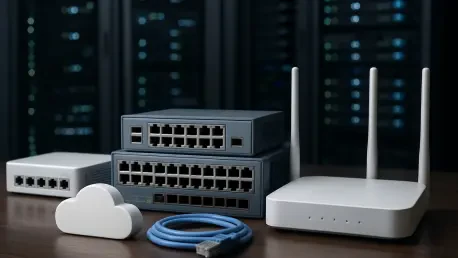What if the very technology designed to propel small and medium-sized enterprises (SMEs) forward became their biggest obstacle? For countless SMEs and their partners—value-added resellers (VARs) and managed service providers (MSPs)—enterprise networking often feels like an unwieldy beast, consuming budgets and time with little return. Complexity in systems meant for larger corporations leaves these businesses struggling to keep up, while partners grapple with shrinking margins. This pervasive challenge sparks a critical question: could simplicity be the key to unlocking growth and efficiency in this space?
The importance of addressing this issue cannot be overstated. SMEs form the backbone of many economies, yet they are frequently underserved by networking solutions that are either too intricate or too costly. Meanwhile, VARs and MSPs face operational inefficiencies that hinder their ability to deliver value. A shift toward streamlined, user-friendly systems could redefine how these businesses connect and compete, offering a lifeline to an often-overlooked segment of the market. This exploration dives into the heart of the problem and the emerging solutions that promise to change the game.
Why Enterprise Networking Frustrates SMEs and Their Partners
Enterprise networking has long been a source of frustration for SMEs, who often lack the resources to navigate labyrinthine systems. Solutions built for multinational giants come with steep learning curves and high costs, leaving smaller businesses overwhelmed. The mismatch between need and design creates a ripple effect, where even basic connectivity becomes a drain on limited budgets and staff.
For VARs and MSPs, the challenges are equally daunting. Multi-tiered licensing models and inconsistent vendor support translate into longer deployment times and repeated customer visits. A recent industry report highlighted that nearly 60% of partners cite complexity as the primary barrier to profitability when serving SMEs, underscoring the urgent need for change in how networking solutions are structured and delivered.
This frustration sets a critical backdrop for understanding why traditional approaches fall short. While large enterprises may absorb the overhead of intricate systems, SMEs and their partners cannot afford such inefficiencies. The stage is set for a deeper look into the roots of this complexity and the potential for a simpler path forward.
Unpacking the Complexity Challenge in SME Networking
The evolution of enterprise networking has not always favored SMEs, as many solutions remain tethered to the needs of larger corporations. Rigid architectures and fragmented support systems create bottlenecks, with deployment times often stretching weeks longer than anticipated. For businesses operating on tight schedules, such delays can disrupt operations and erode trust in technology providers.
Beyond implementation, the financial burden of maintaining these systems weighs heavily on both SMEs and their partners. Complex licensing structures often hide unexpected costs, while profit margins for VARs and MSPs dwindle under the pressure of ongoing troubleshooting. A study by a leading tech consultancy found that partners spend up to 40% of their time resolving issues tied to over-engineered solutions, a statistic that reveals the scale of the problem.
This persistent complexity highlights a growing disconnect in the market. SMEs require reliable, scalable networking without the bloat of unnecessary features, yet they are often forced into one-size-fits-all models. Addressing this gap is not just a matter of convenience but a fundamental step toward empowering smaller businesses to thrive in a digital landscape.
Simplicity on the Rise: A Fresh Approach to SME Networking
A new wave of vendors is stepping into this void, prioritizing simplicity over the scale or bargain-basement pricing that dominates the market. These innovators target what some call the “Unfortunate 50,000”—companies caught between overbuilt enterprise systems and unreliable low-cost options. By focusing on right-sized portfolios, they aim to deliver tools that match the unique needs of SMEs without overwhelming them.
Key features driving this shift include robust cloud connectivity, remote management capabilities, and embedded security designed for smaller-scale operations. Market trends reflect this change, with a 2025 industry analysis showing a 30% uptick in demand for streamlined networking solutions among mid-tier businesses. Real-world success stories, such as a regional retailer slashing deployment time by half with a simplified cloud-managed system, illustrate the tangible impact of these advancements.
This movement toward user-friendly design marks a turning point for the industry. Vendors are no longer just competing on technical specifications but on how effectively they can reduce friction for users and partners alike. As this trend gains momentum, it offers hope that SMEs can finally access enterprise-grade reliability without the traditional headaches.
Ground-Level Insights: Partner Challenges and Vendor Breakthroughs
Feedback from the field paints a vivid picture of the current landscape, with VARs and MSPs voicing concerns over operational hurdles. Many partners describe spending countless hours on-site due to convoluted setups, a frustration compounded by inconsistent vendor support. One MSP shared a striking example of revisiting a client three times in a single month to resolve issues tied to a poorly integrated system, a scenario all too common in this space.
On the flip side, emerging vendors are responding with innovations that prioritize usability. Approaches like pre-staging equipment before delivery and offering design validation services have proven effective in cutting down installation errors. A vendor recently reported a 25% reduction in support tickets after rolling out a simplified management platform, a testament to how targeted solutions can ease partner workloads.
These contrasting perspectives reveal both the depth of the challenge and the potential for transformation. By listening to the struggles of those on the front lines, vendors are crafting tools that address real pain points. This dialogue between partners and providers is shaping a future where simplicity becomes a cornerstone of enterprise networking for SMEs.
Crafting a Simpler Path: Practical Steps for SMEs and Partners
Embracing simplicity requires actionable strategies that SMEs and their networking partners can implement today. One critical step is selecting vendors with transparent pricing and support models, eliminating the hidden costs that often derail budgets. This clarity allows businesses to plan effectively and ensures partners can focus on delivery rather than deciphering complex agreements.
Another vital approach involves leveraging professional services to streamline deployments. Services such as pre-installation testing and post-setup health checks can significantly reduce troubleshooting time. Additionally, prioritizing training programs tailored to real-world applications—like integrating Wi-Fi 7 or managing AV-over-IP—equips partners with skills that directly translate to customer satisfaction and business growth.
Ultimately, building a simpler future hinges on collaboration between SMEs, partners, and vendors. By aligning on solutions that cut through unnecessary complexity, all parties can redirect energy from problem-solving to innovation. This framework not only saves time but also positions SMEs to scale confidently in an increasingly connected world.
Reflecting on the Journey to Simpler Networking
Looking back, the struggle with complex enterprise networking has weighed heavily on SMEs and their partners, creating barriers to growth and efficiency. The persistent mismatch between oversized systems and the needs of smaller businesses has long stifled potential, while VARs and MSPs have wrestled with diminishing returns. Yet, the emergence of simplicity-driven solutions has begun to shift the narrative, offering a glimpse of what is possible when technology aligns with real-world demands.
As this transformation unfolds, it becomes clear that the path ahead rests on a sustained commitment to reducing friction. Vendors have started to pave the way with user-focused innovations, while partners adapt by embracing streamlined tools and services. For SMEs, the opportunity to adopt these solutions means reclaiming time and resources once lost to technical struggles.
Moving forward, the focus should remain on fostering partnerships that prioritize enablement over feature overload. Stakeholders across the ecosystem must continue advocating for right-sized systems, ensuring that simplicity becomes not just a trend but a lasting standard. This collective effort holds the promise of a networking landscape where SMEs and their partners can thrive without the burden of unnecessary complexity.









